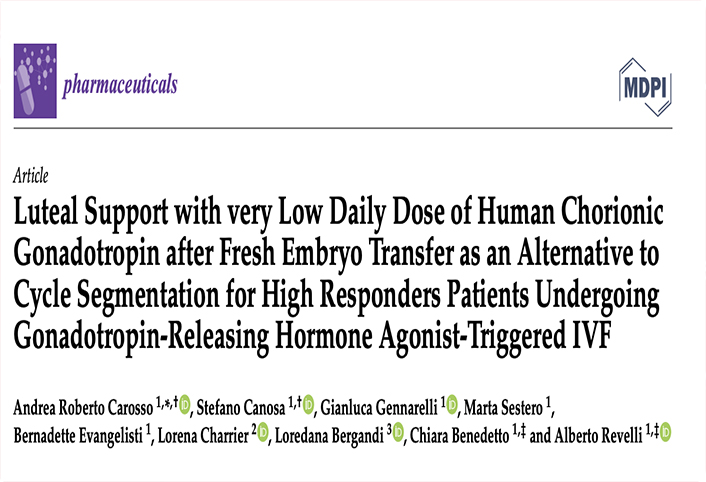
Luteal Support with very Low Daily Dose of Human Chorionic Gonadotropin after Fresh Embryo Transfer as an Alternative to Cycle Segmentation for High Responders Patients Undergoing Gonadotropin-Releasing Hormone Agonist-Triggered IVF
Andrea Roberto Carosso, Stefano Canosa, Gianluca Gennarelli, Marta Sestero, Bernadette Evangelisti, Lorena Charrier, Loredana Bergandi, Chiara Benedetto, Alberto Revelli
Pharmaceuticals (Basel) . 2021 Mar 7;14(3):228. doi: 10.3390/ph14030228.
Abstract
The segmentation of the in vitro fertilization (IVF) cycle, consisting of the freezing of all embryos and the postponement of embryo transfer (ET), has become popular in recent years, with the main purpose of preventing ovarian hyperstimulation syndrome (OHSS) in patients with high response to controlled ovarian stimulation (COS). Indeed cycle segmentation (CS), especially when coupled to a GnRH-agonist trigger, was shown to reduce the incidence of OHSS in high-risk patients. However, CS increases the economic costs and the work amount for IVF laboratories. An alternative strategy is to perform a fresh ET in association with intensive luteal phase pharmacological support, able to overcome the negative effects of the GnRH-agonist trigger on the luteal phase and on endometrial receptivity. In order to compare these two strategies, we performed a retrospective, real-life cohort study including 240 non-polycystic ovarian syndrome (PCO) women with expected high responsiveness to COS (AMH >2.5 ng/mL), who received either fresh ET plus 100 IU daily human chorionic gonadotropin (hCG) as luteal support (FRESH group, n = 133), or cycle segmentation with freezing of all embryos and postponed ET (CS group, n = 107). The primary outcomes were: implantation rate (IR), live birth rate (LBR) after the first ET, and incidence of OHSS. Overall, significantly higher IR and LBR were observed in the CS group than in the FRESH group (42.9% vs. 27.8%, p < 0.05 and 32.7% vs. 19.5%, p < 0.05, respectively); the superiority of CS strategy was particularly evident when 16-19 oocytes were retrieved (LBR 42.2% vs. 9.5%, p = 0.01). Mild OHSS appeared with the same incidence in the two groups, whereas moderate and severe OHSS forms were observed only in the FRESH group (1.5% and 0.8%, respectively). In conclusion, in non-PCO women, high responders submitted to COS with the GnRH-antagonist protocol and GnRH-agonist trigger, CS strategy was associated with higher IR and LBR than the strategy including fresh ET followed by luteal phase support with a low daily hCG dose. CS appears to be advisable, especially when >15 oocytes are retrieved.

